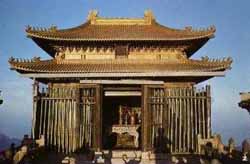|

The Golden Hall in Wudang Mountain lies on the top of the Tianzhu Peak, the highest peak of the mountain.
Wudang Mountain, also named Taihe Mountain, is one of the most famous mountains in China. Located in Danjiangkou of Hunan Province, the mountain consists of seventy-two peaks and covers over 400 square kilometers. The highest peak, called the Tianzhu Peak, reaches 1612 meters above sea level. There are twenty-four caves, three ponds, nine springs, ten pools, nine wells, ten rocks and nine platforms as the scenic spots in the mountain. It is also a famous Taoist site with many palaces, Taoist temples and pavilions. With the fame of one nunnery every two miles and one palace every three miles, the mountain is one of the most popular tourist resorts in China.
The Golden Hall on Wudang Mountain is generally called the Golden Top for it is on the top of the Tianzhu Peak, the highest peak of Wudang Mountain. The construction of the palace was started in the fourteen year (1416) of the Yongle reign in the Ming Dynasty (1368-1644) and that is the largest extant brass cast building in China. The Golden Hall is 5.54 meters high, 4.40 meters wide and 3.15 meters deep with respectively three bays in width and depth. It was brass cast and gold gilt in the style of wooden structured buildings with a double-eaved roof. The ridge of the hall is decorated with vividly shaped gods, men, birds and animals. The hall has twelve stone lotus based columns with exquisitely and elegantly structured brims and rafters. The crossbeams and the ceiling are carved with patterns like clouds and spirals as decoration, of which the lines are soft and smooth. The base of the hall is a stone platform made of granite rocks, circled with engraved stone railings. All the josses, altars and sacrificial vessels are brass cast. In the center is enshrined the Zhen Wu Emperor, who is a bear footed strong and tall man with disheveled hair wearing a gown and a suit of armor. Beside him stand the statues of a lovely boy and a pretty girl, who look modest, obedient and graceful. On the two sides stand the statues of the two brave and stately generals named Water and Fire, which show the artistic essence of all the brass cast statues in Wudang Mountain.
The Golden Hall was first cast part by part, which were then riveted and welded together. The connection was precise and integrated without any marks of cast or chisel. Despite of the natural erosion and thunder hits for over five hundred years, the palace is still goldenly splendid as if it was new and is regarded as a pearl in the history of ancient architecture and casting technology in China.
Along the mountainside of the peak under the palace lies a circle of stone wall named the Zijin (purple gold) City. Facing the cliff and standing high, the wall is 1.5 kilometers long with four stone gates. The steepness adds to the impression of loftiness.
Ascending to the Golden Hall and overlooking around, you will see the mountains standing erect like a gorgeous green screen. The Danjiang Reservoir is as quiet and smooth as a mirror. The Tahe, Nanyan and Wulong palaces are positioned in order with a compact layout. Watching the sunrise in the morning and enjoying the cloud sea in the evening, the tourists would feel they have really come to a fairyland.
On the Xiaolian Peak of Wudang Mountain there is a palace moved from the highest Tianzhu Peak in the fourteenth year (1416) of the Yongle reign in the Ming dynasty. It was cast with brass in the eleventh year (1307) of the Dade reign in the Yuan Dynasty (1271-1368). That is the oldest extant brass cast building in China.
|